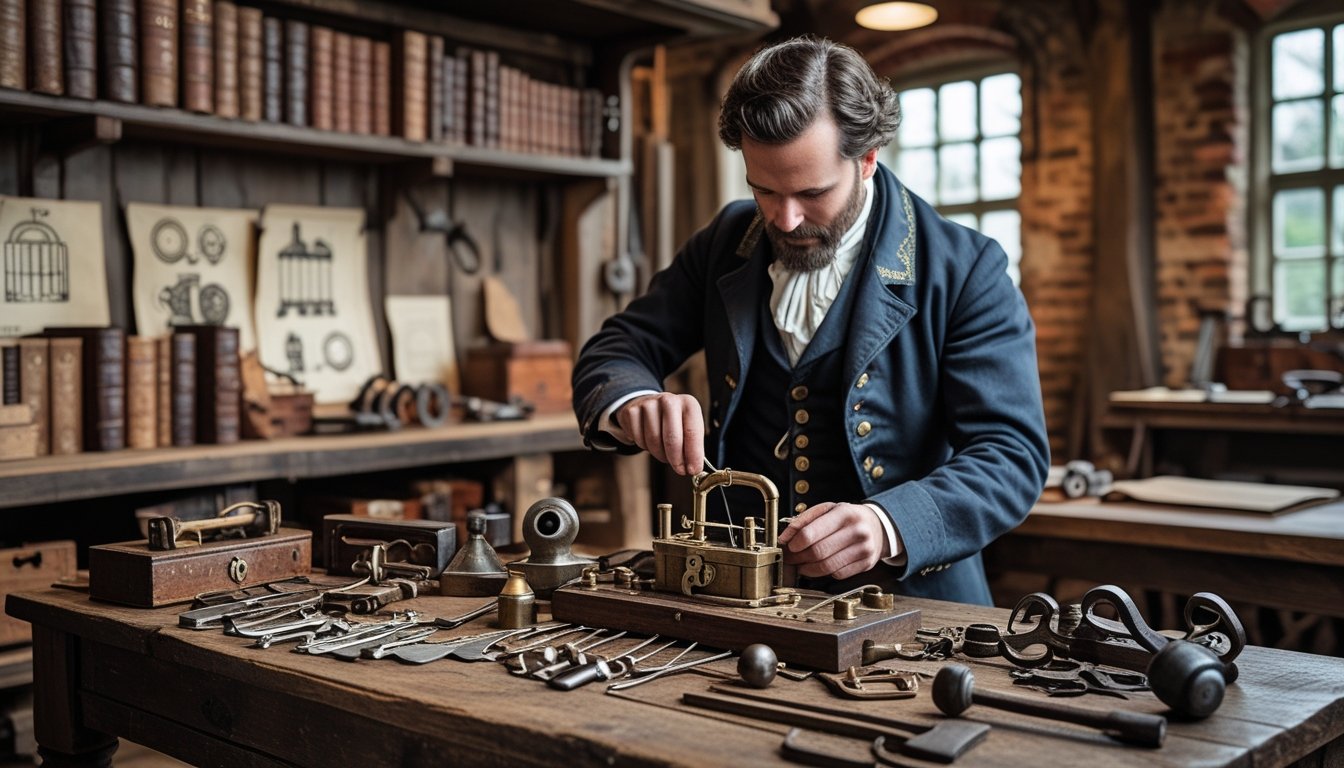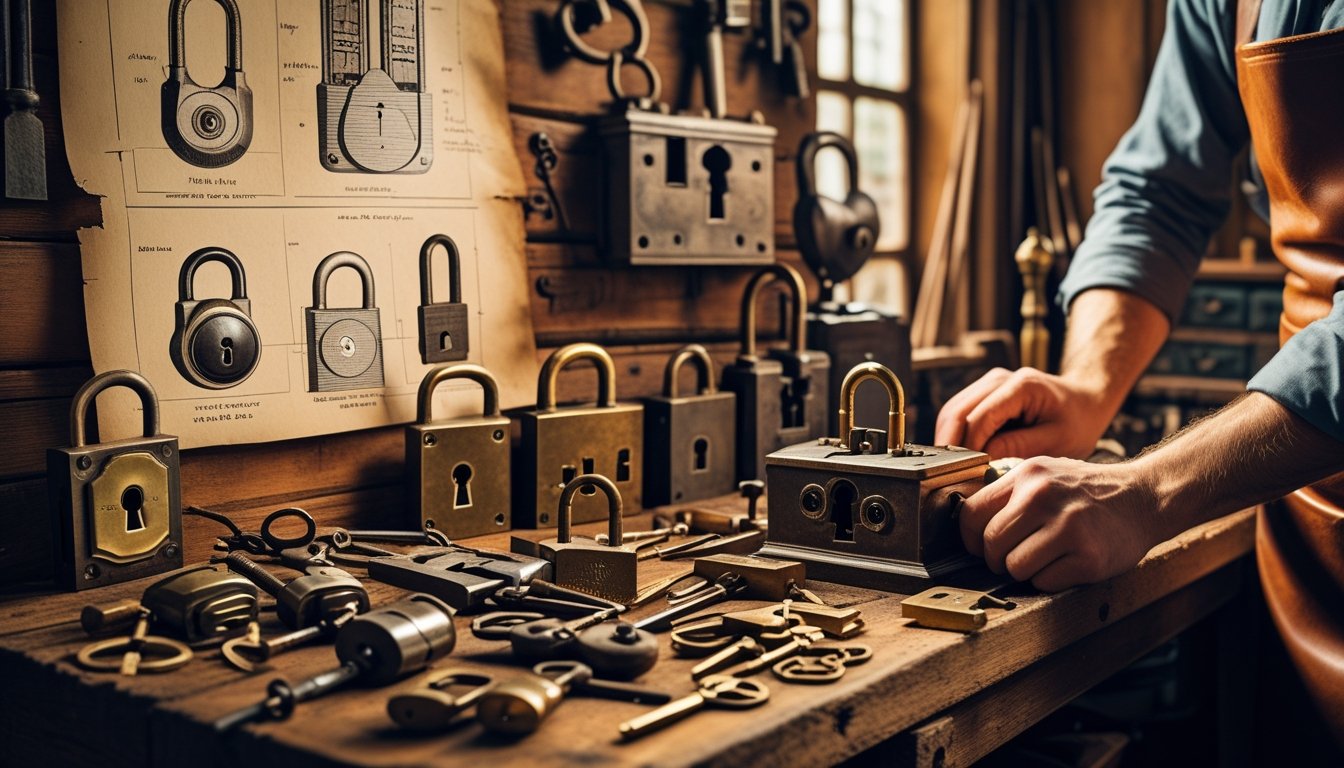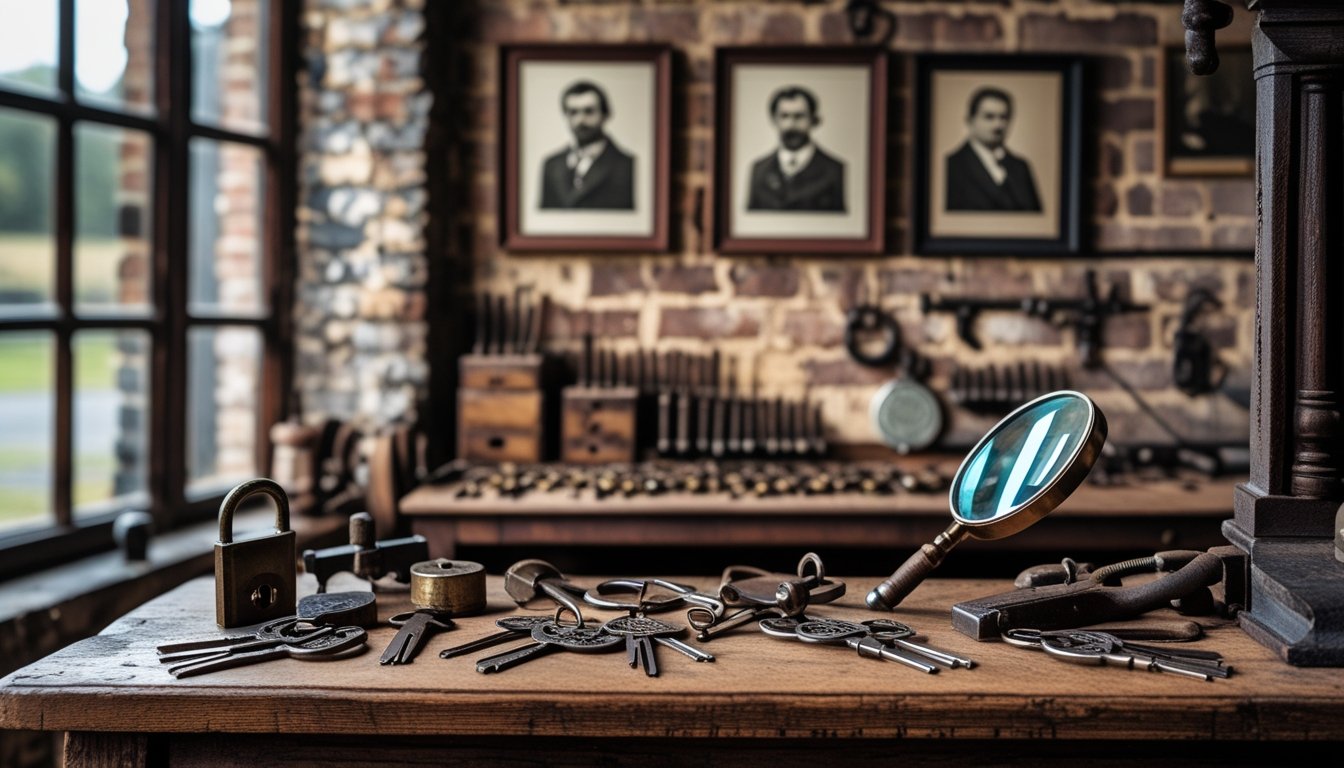Late updated: 29 Sep 2025 15:09
Written by: Elena Prescott
Historical Overview Of Locksmithing Practices In The UK: Evolution And Impact
Locksmithing in the UK has a storied past that intertwines with the nation’s historical tapestry, dating back centuries. Today, we explore how this ancient craft evolved from rudimentary practices in the Anglo-Saxon era to more sophisticated techniques during the mediaeval period. These shifts not only highlight the craftsmanship and innovation of their time but also reveal our societal transformations.

Originating in the ancient civilisations of Egypt and Babylon, simple lock mechanisms safeguarded valuables millennia ago. As trade routes flourished, these early designs found their way to the British Isles, setting the foundation for a trade that blossomed during the Middle Ages. The evolution of locksmithing mirrored the growth of British cities as demands for security increased.
The Middle Ages introduced significant advancements like the warded lock, marking a period when locksmiths became respected figures within communities. By the late Mediaeval period, the formation of guilds formalised their practices, allowing for a standardisation of skills and quality. Understanding this evolution helps us appreciate how ancient ingenuity paved the way for modern innovations in security.
Key Takeaways
- Locksmithing in the UK started during the Anglo-Saxon era.
- The craft evolved through the Middle Ages with innovations like the warded lock.
- Guilds played a key role in professionalising and standardising the trade.
Origins and Evolution of Locksmithing in the UK
Locksmithing in the UK boasts a rich history, deeply rooted in ancient practices that laid the foundation for modern security systems. In this exploration, we examine how early locksmiths and their ingenious lock mechanisms set the stage for pivotal innovations. Important figures such as Robert Barron and Joseph Bramah are highlighted for their significant contributions, leading to a transformation of security practices and the adoption of contemporary security solutions.
Early Locksmiths and Lock Mechanisms
Locksmithing in the UK can trace its origins back to ancient civilisations like the Egyptians and Babylonians. Early locks were often crafted from wood, utilising a basic pin tumbler system. As time progressed, the Roman influence brought iron and bronze locks, significantly enhancing durability. During the Middle Ages, the role of a locksmith became more defined, with craftsmen fashioning intricate metal locks to secure valuables. This period saw the rise of simple warded locks, which remained common throughout medieval England. The formation of guilds further solidified the trade, establishing standards and encouraging innovation in lock design.
Pivotal Innovations and Inventors
The developments in lock design during the 18th and 19th centuries were revolutionary. Innovators like Robert Barron and Joseph Bramah were at the forefront. In 1778, Barron introduced the double-acting tumbler lock, which significantly improved security measures by requiring two bars to be lifted simultaneously. Just eleven years later, Bramah patented the Bramah lock, renowned for its complexity and resistance to picking, setting a new standard in security. These innovations turned locksmithing from a craft into a sophisticated science, demanding precision and ingenuity in the development of more secure locks.
Transformation of Security Practices
The Industrial Revolution drove significant advancements in the locksmithing industry. Mass production techniques allowed for locks to be made at a scale never seen before, making security solutions more accessible. The industrialisation of Britain facilitated the spread of new lock designs, including the highly efficient lever tumbler lock. This period also saw a shift in security practices, as businesses and households began adopting comprehensive security measures to protect against increasing threats of theft. Locksmiths became essential advisors in selecting the best security systems for each situation, tailoring solutions to the specific needs of clients.
Adoption of Modern Security Solutions
The late 20th and early 21st centuries marked the advent of electronic and smart locks, fundamentally transforming locksmithing. Traditional mechanical locks were gradually supplemented by digital solutions, offering enhanced security features like biometric verification and remote access. These innovations have allowed us to integrate advanced security measures into buildings, creating a seamless blend of traditional craftsmanship and modern technology. As the demand for higher-level security continues to rise, locksmiths remain vital in guiding customers through the myriad of available options, ensuring optimal protection that meets contemporary standards.
Key Developments and Practices in British Locksmithing

British locksmithing has a long and storied history. This section explores significant advancements, including improvements in key cutting, the introduction of masterkey systems, breakthroughs in lock security testing, and developments in safes and architectural hardware.
Evolution of Key Cutting and Duplication
In the early days of locksmithing, each key was individually handcrafted, which was time-consuming and costly. The advent of machine-driven key cutting revolutionised this process by allowing precise duplication of keys at a fraction of the time and cost. With the introduction of modern cutting techniques, key duplication became more accurate. These methods are used not only in homes but extensively in businesses requiring multiple identical keys.
The shift from manual to automated key cutting techniques has exponentially increased efficiency. Today, advanced machines can replicate a variety of keys, including those with complex designs. We’ve also seen digital solutions allowing precise key creation without needing the original key, greatly enhancing convenience. These techniques have become critical in maintaining access control and security.
Masterkeying and Access Control Systems
The concept of masterkeying has been pivotal in managing access across large facilities. This system allows multiple locks to be opened by a single master key while each lock still functions with its individual key. This versatility is essential in places like hotels, office complexes, and educational institutions. As a result, these systems enhance security by simplifying the management of key distribution.
With technological progress, electronic access control systems have gained prominence. These systems use codes or cards to grant access, giving administrators the ability to track and control entry in real-time. The integration of Internet of Things (IoT) and home automation systems has further revolutionised security, allowing remote management through smart devices, thus providing both efficiency and improved safety.
Advancements in Lock Picking and Security Testing
Lock picking has evolved from a clandestine activity to a valuable aspect of security testing. Modern locksmiths use advanced lock picks and tools designed for non-destructive entry, emphasising the importance of ethical lock picking in assessing vulnerabilities and reinforcing lock systems. This practice allows security professionals to identify weaknesses before they are exploited.
Security testing has expanded to include various lock types and mechanisms, from traditional pin-and-tumbler designs to smart locks. Through controlled testing environments, locksmiths and security professionals can predict and improve a lock's resilience to tampering. Education in these methods is vital, as it helps protect against unauthorised access and keeps up with the increasing complexity of security applications.
Safes, Handles, and Architectural Hardware
Safes have become indispensable in safeguarding valuables against burglary and fire. Modern safes are crafted with materials that withstand high temperatures and physical attacks, incorporating technological advancements such as biometric access. This innovation ensures maximum protection of sensitive materials.
Handles and architectural hardware have also seen numerous improvements. They are now designed to blend security with aesthetics, integrating seamlessly into various environments. Smart handles with electronic locking mechanisms are gaining popularity, allowing remote lock management. This blend of function and form keeps security robust while enhancing the attractiveness of buildings, embodying the evolution of British locksmithing in its quest for innovation and quality.
Frequently Asked Questions

Our exploration of the locksmithing history in the UK sheds light on the ancient origins of the craft, transformations during pivotal eras such as the Industrial Revolution, and the impacts of conflicts like World War II. We also touch on the evolution of lock mechanisms and current regulations shaping the industry today.
What are the origins of locksmithing in the United Kingdom?
Locksmithing in the UK traces its beginnings to ancient times, when wooden locks secured personal belongings. These early devices were simple yet effective. Later, medieval locksmiths elevated the craft to an art form, creating ornate locks and keys designed for cathedrals and palaces.
How did the Industrial Revolution impact locksmithing techniques in Britain?
The Industrial Revolution brought significant advances in locksmithing. With the advent of mass production and machining, lock mechanisms became more complex and secure. Locksmiths could produce higher volumes of locks, ensuring they were both affordable and widely available to the general populace.
What were the common lock mechanisms used in Victorian-era Britain?
During the Victorian era, locksmiths commonly employed warded locks and lever tumbler mechanisms. These designs offered increased security compared to earlier models. They were frequently used in residential and commercial settings, enhancing the safety of structures throughout Britain.
How have British locksmiths contributed to modern lock designs?
British locksmiths have been instrumental in advancing modern lock technologies. Innovations like the high-security Bramah Lock, designed in London, set a new standard for locking mechanisms worldwide. Their expertise has continually driven the evolution of secure and robust lock designs.
In what ways did World War II affect the locksmith industry in the UK?
World War II had a profound impact on the locksmith industry. Demand for secure locks increased significantly, driven by the need to protect critical infrastructure and military installations. This period encouraged the development of more sophisticated and resilient locking systems, contributing to the industry's growth.
What are the current regulations governing the practice of locksmithing in the UK?
Present-day locksmithing in the UK is regulated to ensure safety and professionalism. Locksmiths must adhere to standards set by organisations such as the Master Locksmiths Association. These regulations ensure practitioners are qualified and competent to meet the security needs of customers across the country.
